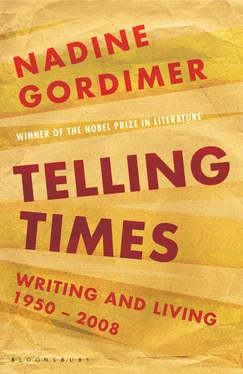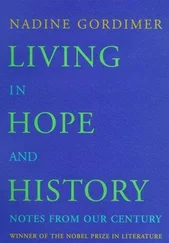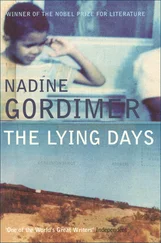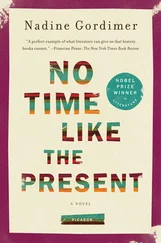What we wanted at this stage in our lives, and what we usually got, since, like many parents, ours acquired the tastes of their children, being formed rather than forming, was a holiday at a South Coast village beyond the reach of even the little single-track railway. In this village, the hotel was a collection of thatch-roofed rondavels, the water was free of refuse, and the beach — ah, the beach lay gleaming, silent, mile after mile, looping over flower-strewn rocks; there were, indeed, many beaches, and always one where for the whole day there would be no footprints in the sand but my sister’s and mine. In fine weather, the village was, I suppose, a paradise of sorts. In front of the little hotel was the warm, bright sea, and, curving around behind it, hill after hill covered with the improbable green sheen of sugar cane, which, moving in the breeze, softened every contour like some rich pile, or like that heavy bloom of pollen which makes hazy the inner convolutions of certain flowers. Streams oozed down from the hills and could be discovered by the ear only, since they were completely covered by low, umbrella-shaped trees (these are seen to better advantage on the hills around Durban, where their peculiarly Japanese beauty is unobstructed by undergrowth), latticed and knitted and strung together by a cat’s cradle of lianas and creepers. My sister and I would push and slither our way into these dim, secret places, glimpsing, for the instant in which we leaned over, the greenish, startling image of our faces in water that endlessly reflected back to the ferns the Narcissus image of their own fronds.
More cheerfully, in the bush along the road we would sometimes hear that incredibly light-hearted, gossipy chatter which means that monkeys are about. The little Natal coast monkeys are charming creatures, in appearance exactly the sort of monkey toy manufacturers choose; in fact, they are just what one would wish a monkey to be. They bound about in the treetops, nonchalant and excitable at the same time, and unless they are half tame, as they have become around some of the road-houses on the outskirts of Durban, they move off almost too quickly to be clearly seen; you find yourself left standing and gazing at the branches as they swing back into place and listening to the gaiety as it passes out of hearing, and the whole thing has the feeling of a party to which you have not been invited. If the monkeys, like distant relatives who wish to make it clear that there is no connection, ignored us, there were creatures who, because their movements were attuned to some other age of slime or rock, could not escape us. On the trailing plants near the rocks, sleepy chameleons stalked shakily, or clung swaying, their eyes closed and their claws, so like minute, cold human hands, holding on for dear life. If they saw you coming for them, they would go off nervously, high-stepping across the sand, but with a kind of hopelessness, as if they knew that all you had to do was lean over and pick them up. And then, unable to bite, scratch, sting, or even to make any protest other than to hiss faintly and hoarsely, they wrapped their little cold hands around your finger like a tired child and went as pale as they could — a lightly spotted creamy beige that was apparently their idea of approximating the colour of human skin. My sister was particularly fond of these resigned and melancholy creatures. Twice we took one home to the Transvaal with us on the train, and twice we watched and wept in anguish when, after two or three happy months on the house plant in my mother’s living room, the poor thing lost first his ability to change colour, fading instead to a more ghostly pallor each day, and then, literally, his grip, so that he kept falling to the floor. The Transvaal winter, even indoors, was too much for chameleons.
In the heavy green water of the lagoon at the South Coast village where we used to stay, there appeared to be no life at all, though some people said that under the rocks at the bottom there were giant crabs. When the weather was bad for a few days, and the combination of the sea’s rising and the lagoon’s flooding washed away the sandbanks between the lagoon and the sea, the dark river water in the lagoon poured in a deep channel down into the waves, and the waves mounted the river water, frothing over the swirl. Decaying palm leaves, the rotten ropes of broken lianas, and fallen vegetable-ivory fruit, as hard and round as cricket balls, were washed out of the stagnant bed of the lagoon and brushed you weirdly while you swam in the sea. Once, late one afternoon, my mother and I were lying on the sand watching a solitary swimmer who evidently did not mind the dirty sea. Suddenly we saw the rhythmic flaying of his arms against the water violently interrupted, and then he heaved clear up into the air, gripping or in the grip of a black shape as big as he was. My mother was convinced that he had been attacked by a shark, and went stumbling and flying over the sand to get help from the hotel. I went, with that instinct to seek human solidarity in the face of any sort of danger towards humankind, to stand with some excited children who had been playing with toy boats at the water’s edge. I was four or five years older than the eldest of them, and I kept holding them back from the water with the barrier of my outspread arms, like a policeman at a parade. What danger I thought there could be in two or three inches of water I cannot imagine, but the idea that there was a monster in the vicinity seemed to make even the touch of the water’s edge a touch of menace.
In minutes, the whole village was on the beach, and out there, but coming nearer with every wave, were the swimmer and the dark shape, now together, now apart, now lost, now discovered again. As the lifesaving rope was unreeled and the volunteer lifesavers plunged into the sea, supposition was shrill, but hastily silenced at the occasional cry of ‘Look, there he is!’ There was a feeling of special horror, oddly, because it was obvious that the creature was not a shark; with a shark, one knew exactly what it was one had to be afraid of. And then the cry went up: ‘It’s a crocodile! It’s a crocodile!’ Even the lifesavers heard it, and looked back towards the shore, confused. Before they could get to the swimmer, he was in water shallow enough for him to stand, and we could see him very clearly, his face grim and wild with water and effort, his hands locked around the long snout of a big reptile, which seemed to gather up the rest of its body in an attempt to kick him, rather than to thrash at him with its tail, as crocodiles are said to do. ‘A crocodile!’ the cry went up again. ‘Enormous!’ Men rushed into the shallow water with pocketknives and weapons of driftwood. Yet the man staggered up on to the beach with his monster alone. He was a short, stocky man, and it was true that the thing was as big as he was. It seemed stunned, and he kept hitting it across the snout with his fist, as if to say, ‘That will show you!’ Amid the screams and the squeals, and the confusion of lifesavers, rope, brandished driftwood, and Boy Scout knives, he beat it to death himself; it was plain that, exhausted though he was, he wanted the privilege of being the conqueror. Then he sat on the sand, sniffing deeply, his chest heaving, a flask of brandy trembling in his hand; I remember so well how he said, in an incredulous, rasping voice, ‘Crocodile that size could’ve torn one of those kids in half.’
The man was a great hero for half an hour. Then an old retired major who had lived in the district for many years and was a botanist and naturalist came over the sand, leaning on his little cane, and prodded at the monster lying there disfigured by blows and sand. ‘Leguan,’ the major said. ‘Old leguan — poor old lizard wouldn’t harm a fly. Must’ve been trying to get back to the lagoon.’ The major was quite right. The beast was not a crocodile but one of those giant lizards, the leguans, that are still fairly common all over South Africa but are careful to keep out of the way of man — as timid and, indeed, except for their frightening size and resemblance to the crocodile family, as defenceless as the chameleon. He would not have bitten the swimmer, and he was too stupid and clumsy even to use his weight to defend himself. The man had done battle with the most reluctant of dragons. So, with the wiliness of human beings, who hate to admit that they have been taken in and must turn their gullibility to advantage somehow, the people in the village and at the hotel were quick to make a kind of joke of the swimmer; where before his words ‘Could’ve torn one of those kids in half’ had made him seem the saviour of their children, now they saw something absurd in the dramatic way he had struggled to bring the creature in instead of making for the shore and his own safety. He went about the hotel for the rest of his holiday very much alone, and a little sullen perhaps.
Читать дальше












